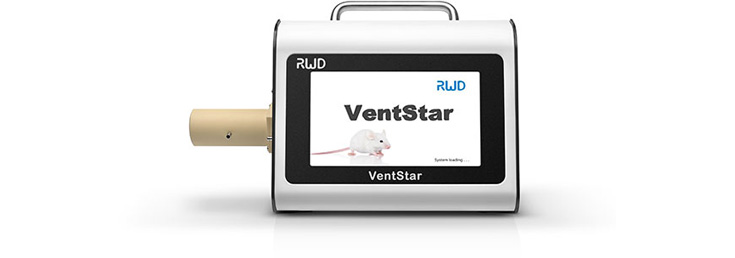
R415 VentStar Small Animal Ventilator
Animal ventilator is the commonest instrument for assisting animal respiration, which is widely used in scientific researches of preclinical medicine, clinical medicine and veterinary medicine (such as myocardial ischemia model), as well as respiratory management in animal surgery, emergency treatment and respiratory therapy.
Features:
- Suitable for mice, rats and guinea pigs and other animals weighing 10 g - 1 kg
- Simple and elegant appearance, color matching, compact layout, compact overall size, easy to operate, flexible; Provide safe and effective intermittent positive pressure ventilation (IPPV), supporting capacitive/pressure-controlled ventilation modes.
- It can store 10 sets of different respiratory parameters, which can be adjusted with one key, convenient and quick.
- Display specifications: 7" LCD resistive color touch screen, wide Angle visual.
- Support breathing frequency switching between 10 to 300 BPM, tidal volume 0.05 ml ~ 5 ml, 1 ~ 50 cm H2O airway pressure cap, can be set in a combination of PIP/PEEP/Sigh/INSP. Hold/EXP. Hold/respiratory parameters such as.
- It can display the pressure-time curve in full screen in real time under the two ventilation modes of capacitive control/pressure control.
- Voice alarm, intelligent text message prompt, error code query, improve the man-machine interaction between the device and the user, reduce human error in the use process.
Technical Specifications:
Suggested Weight Range 10 g ~ 1 kg
Species Mouse/Rat ~ Guinea Pig
Tidal Volume Range (TV) 0.05 m l~ 5 ml Resolution: 0.001 ml
Peak Inspiratory Pressure (PIP) 1 ~ 50 cm H2O Resolution: 1 cm H2O
Accuracy: ± 0.7 cm H2O
PEEP 0 ~ 10 cm H2O Resolution: 1 cm H2O
Breath Rate (bpm) 10 ~ 300 bpm
I:E Ratio 20 ~ 80 %
Sigh Breath Frequency: Every 10 ~ 999 or Manual
Volume: 0 ~ 20 % of tidal volume (in volume mode) or PIP (in pressure volume)
Display 7’’ LCD touchscreen, resistive
Remote Communication RS-485
Power Supply 100 ~ 240 V AC, 50/60 Hz
Input Power 24V DC, adaptor: 40 W Max
Safety Alarms Over-/Under-pressure, occlusion, high PEEP
Dimensions 320 * 210 * 180 mm
Weight 5.1 kg
Operating Temperature 4 ℃ ~ 40 ℃ (40 °F ~ 104 °F)
Operating Humidity 20 ~ 80 %, non-condensing
Storage Temperature & Humidity -10 ℃ ~ 70 ℃ (14 °F ~ 158 °F), 20 % ~ 80 % RH, non-condensing
Ordering Information:
| Cat No. | Product Description |
| R415 | Small Animal Ventilator |
| R415-AP | Accessory package for Anesthesia and Ventilator |
About RWD Anesthesia
RWD Life Science has been always dedicated to study and provide perfect and competitive inhalation anesthesia systems that have great practical value to the life science research community. Multiple complete solutions to different procedures in mice, rats, rabbits, cats, dogs, monkey, pig etc. have been set up, which has remarkable and even exclusive advantages over existing system, for example:
- Precise and stable control of anesthetic agents output regardless of environmental changes like pressure, temperature and air flow within the specific limits.
- The miniaturized design like anesthesia machines and scavenging system helps to improve laboratory space utilization.
- Unique stereotaxic frame nosecone masks and cone masks with tiny sizes satisfy more delicate surgeries like craniocerebral and ophthalmological surgery, and at the same time minimize harmful exposure to the research subjects while connecting to evacuation system.
- The latest-designed waste gas evacuation system with weighing (Cat No.R546W) brings research subjects great convenience.
- Higher performance to price ratio helps research subjects to reduce their expense while maintaining successful research.
- High adsorption efficiency of activated charcoal filter canister (Cat No.R510-31 & R510-31S).
Advantages of Inhalation Anesthesia:
- Can offer an improved level of control over depth and duration of anesthesia, especially for prolonged procedures.
- To be relatively insoluble and faster elimination in blood enables rapid recovery.
- Be of rapid onset and offset with minimal side effects.
- Have little or no toxic effects thanks to non-metabolism characteristic of Sevoflurane and Isoflurane.
- Be more safer and efficient performance to reduce morbidity rates and increase the chance for successful outcomes.
